Featurephones, dumbphones, "messaging phones." No matter what you call them, it's clear that these devices are quickly being replaced by cheap smartphones at the low end of the cellphone market. We've seen devices like the LG Lucid and the HTC One V, or the Sony Xperia U in the UK, all of which bring lower specs and weakened performance, but still offer all (or at least most) of a smartphone's connectivity and functionality.
That's precisely what T-Mobile's latest MyTouch and MyTouch Q purport to be. The new devices are $49.99 with a two-year contract, a price historically reserved for phones with nine keys, a clamshell body, and no internet connection. Their spec sheets are lackluster, at least compared to T-Mobile's more expensive smartphones: 1.4GHz single-core processors, 5-megapixel cameras, and 4-inch 800 x 480 displays. (The only difference between the models is that the Q has a slide-out QWERTY keyboard at the cost of thickness, while the basic MyTouch doesn't.) But they should be a huge improvement for first-time smartphone buyers.
The entry-level smartphone is very much here. But what's the cost of saving $150 over T-Mobile's high-end handsets? And is it worth it? Let's see.
In the effort to bring costs (and thus price) down, build quality is typically the first thing sacrificed; that's why it was so surprising that the MyTouch and MyTouch Q both feel impressively well-made. Physically they're virtually identical, with soft but grippy rubber backs and gray plastic edges (both also come in red). Rounded corners and barely tapered edges make both phones feel hefty when you pick them up, but they're sturdy and well-made (and I suspect able to take a beating).
Huawei is the manufacturer behind both new MyTouch models, and the company clearly took some design cues from the Nexus One. It has the slightest of chins at the bottom, though sadly there's no trackball on the MyTouches. Just above the chin are four capacitive buttons, but only three are likely to be familiar. In addition to Menu, Home, and Back, there's a green Genius Button (it's apparently version 4.0) that launches a Siri-like voice-control service powered by Nuance. In the world of Google Now and even Google's previous voice search, this is entirely superfluous, but it works well, and as you'll see later the MyTouch isn't living in the world of Google Now.
There's a power button on the top of each phone, next to a 3.5mm headphone jack; a volume rocker lives on the left side, and a dedicated camera button on the right. Both phones charge via their Micro USB ports; it's on the bottom of the MyTouch, but on the left side of the Q (which becomes the bottom when you pop out the keyboard). There's a silver grille for the earpiece at the top, and the speaker rests on the back of the phone. There's a MyTouch logo on the front and another on the back below a T-Mobile logo, which is itself underneath the camera lens and LED flash. The SIM card is hidden underneath the removable back, as is the microSD slot. Everything's fairly clean and minimal, and though I wouldn't call either phone attractive they're certainly not ugly either.
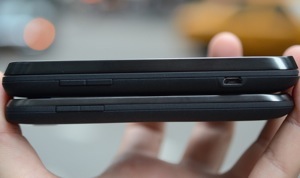
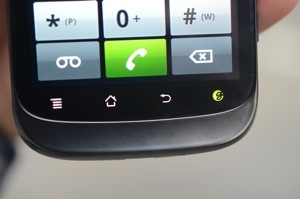
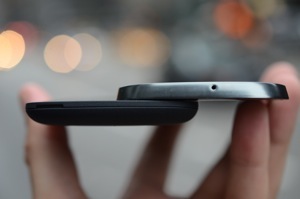
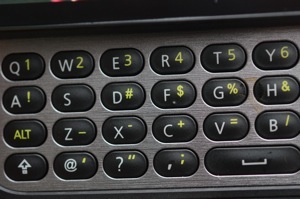
At 4.8 inches tall, 2.5 inches wide, and .41 inches (10.4mm) thick, the MyTouch is a little thick for its size but still fits easily into one hand. The Q is a hair longer and wider, but more than 4mm thicker — it's a definite brick to hold. There's a good reason, though: the Q has a full-size QWERTY keyboard that slides out to the left side of the phone — were it absent the two handsets would be virtually identical.
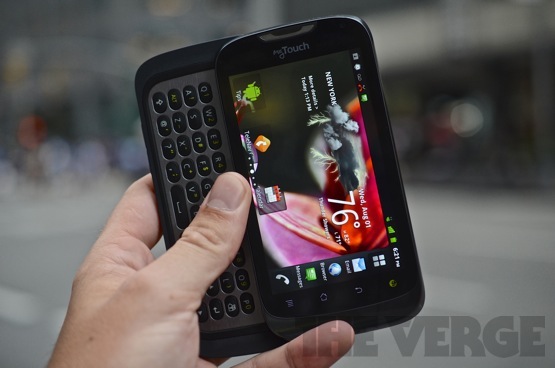
The keyboard will be familiar to owners of old MyTouch models; it's more a refinement than an overhaul. The four rows of keys are nicely spaced, so you won't often hit the wrong one, but there's so little feedback that it's hard to tell if you've hit one at all. The keyboard has a backlight, but it only turns on when you slide the keyboard out the first time — for the life of me I can't find a way to turn it on manually. Also, when you press and hold a key, instead of entering a capital letter or the alternative symbol, it gives you accented characters for the letter you're pressing. That seems like the least-useful thing to do in that situation, but you'll quickly get used to just pressing the Shift and Alt keys a lot.
I'm sure the keyboard will benefit some people used to physical keys, though personally I wound up leaving the device closed and using the stock Android keyboard most of the time — but hey, I guess that's why there are two MyTouch models.
Display
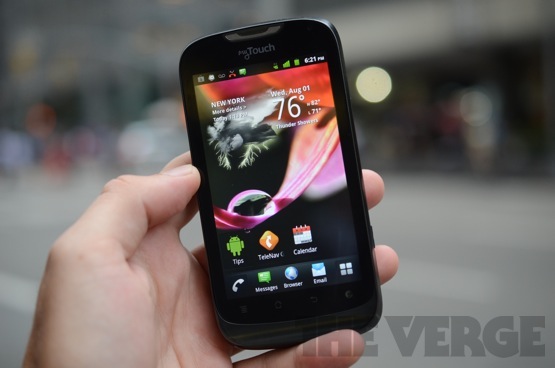
The MyTouches remind me a lot of the original Galaxy S (I had a Fascinate back in the day). They're both well-made, decent-looking phones, until you turn on their 800 x 480 display. The MyTouches' LCD is generally a good one, with solid viewing angles and decent color reproduction — blacks and whites are both a bit dull, but things still look pretty good. The resolution is the problem: we've grown used to Retina, 720p, and the like, and it's hard to go back. Dropping down to WVGA — which makes small text look jaggy, makes icons enormous, and prevents you from watching any kind of HD video — is surely a cost-saving move to reach that $49 price, but even a slight step up to qHD (960 x 540) would've made a huge difference.
The screen is responsive to touch, and reliably taps the right thing — lower-res, smaller screens usually make me worry about keyboard accuracy, but the MyTouch keyboards (Swype comes preinstalled, or you can use the stock Android keyboard) do fine. It does appear to be set well below the layer of glass, and it doesn't actually feel like you're touching an icon or a key. For a $49 handset these compromises are understandable, but they're still unfortunate.
$49 phones have to compromise somewhere
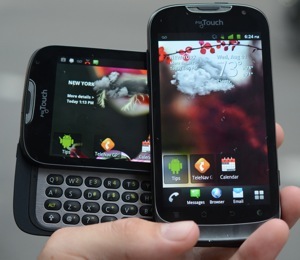
Cameras
Certainly better than your feature phone


From the moment I started using the MyTouches, I hated their cameras. It's all the lock screen's fault: I've all been trained to swipe to the right to unlock the phone, but when you do that on these phones it goes straight into the camera. Once I learned to drag down (and read the instructions on the screen, which say "drag down") I was actually a bit impressed with the 5-megapixel rear shooters on the MyTouch and the Q.
I should clarify: they're not good cameras, not by a long shot. Photos are still soft and noisy, and in low light are unusable. But for those "the best camera is the one you have with you" moments, it's not a terrible option. Both phones' cameras can also autofocus, which is hugely useful; it's pretty slow, as is the camera overall, but it helps take slightly sharper pictures.
You can also shoot 720p video with the rear camera, which is the same: functional, but don't rely on it to capture your most precious memories. Ditto the 0.3-megapixel front-facing camera, which is fine for video chat (as long as you're in a well-lit room) but too grainy for anything you want to preserve. Basically, the MyTouches both have a market-average smartphone camera, at a below-average price point. I'll take that.
Software and performance
Every new Gingerbread phone makes me a little angrier
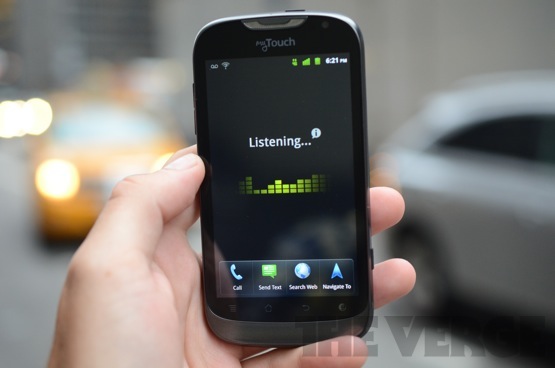
Let me be clear: it is absolutely, unequivocally unacceptable to launch a phone in August of 2012 that runs Android 2.3. I don't care how much it costs. Gingerbread is now three major revisions of Android behind, and there's no easier way to appreciate Android 4.0 than to pick up a MyTouch. Gingerbread is uglier and less cohesive, with little of the design attention the company lavished on Ice Cream Sandwich. It's also considerably less powerful, with stutters and lags that simply aren't present on newer versions of the software. No matter the price tag, I don't know if I can recommend a phone running such outdated software to anyone — even if you're stepping up from a feature phone you're going to quickly grow frustrated with Gingerbread's myriad problems.
Then there's the app issue: a number of Android's best apps and features, from Gmail to Chrome to Google Now, are either entirely absent in Gingerbread or (in Gmail's case) far worse. T-Mobile valiantly tries to replace Google Now with Genius, the voice-controlled app that lets you send texts or do quick searches; the app works reasonably well, but Google's app is better-looking, more powerful, and ultimately more useful.
T-Mobile and Huawei make matters even worse by slathering an eyesore of a UI skin all over Gingerbread. At least Sony has the good sense to add some useful functionality and not overhaul the UI on the Xperia models — the MyTouches could stand to learn a thing or two. Functionally, little is changed, but a lot of menus and icons are customized for the worst. The worst offense is the huge toolbars — in the app drawer, for instance, there's a search bar and sorting tabs on top and a dock on the bottom, so a third of the screen is already taken. The notification pulldown has gigantic power and radio controls, plus a large bar just to remind you that you have a T-Mobile phone — that's a third of your screen that isn't showing, you know, notifications. On a purely aesthetic note, the not-quite-transparent square borders around every icon are absolutely hideous, reminiscent of LG's thankfully now-forsaken skin on the Lucid and others.
There's also a laundry list of bloatware apps preinstalled, furthering the notion that T-Mobile is taking advantage of users who might not know there's a better Android experience out there. There are a dozen or so carrier-branded apps, like T-Mobile Mail and T-Mobile TV, but fortunately if you just train yourself to ignore pink icons (or only use the "Downloads" tab) you won't notice them anymore. Facebook, Slacker, Monopoly (insanely fun on a phone, by the way), Documents to Go, and a few others come installed as well. Some of the apps can be removed, but it's clear that one of the ways T-Mobile offsets the cost of the phone is by filling it with crapware.
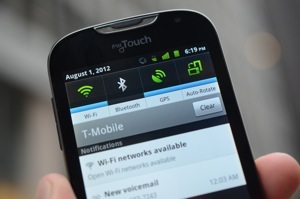

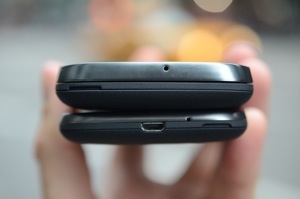
It's a high-end smartphone — from two years ago
Performance
The slight silver lining is that the UI customizations don't seem to have much effect on the overall performance of the MyTouch and MyTouch Q. Both are powered by a single-core Qualcomm 1.4GHz processor, and for most things that's perfectly sufficient. There are some lags and slowdowns, and most things are a beat slower than a device like the Galaxy S III — particularly if you're a heavy multitasked — but most actions work as you'd expect. Even intensive games like Shadowgun are playable, though there's the occasional stutter or dropped frame.
| Quadrant | Vellamo | GLB 2.1 Egypt (720p) | GLB 2.1 Egypt (1080p) | AnTuTu | |
|---|---|---|---|---|---|
| T-Mobile MyTouch | 1,948 | 1,007 | 20fps | 10fps | 3,617 |
| T-Mobile MyTouch Q | 1,967 | 1,014 | 20fps | 10fps | 3,532 |
| Sony Xperia U | 2,466 | 1,090 | 20fps | 10fps | 5,430 |
| Galaxy Nexus | 2,002 | 1,065 | 28fps | 14fps | 6,079 |
| HTC One S | 5,141 | 2,420 | 57fps | 29fps | 7,107 |
| HTC One V | 2,060 | 1,155 | 32fps | 18fps | 2,515 |
Battery life, reception, and call quality
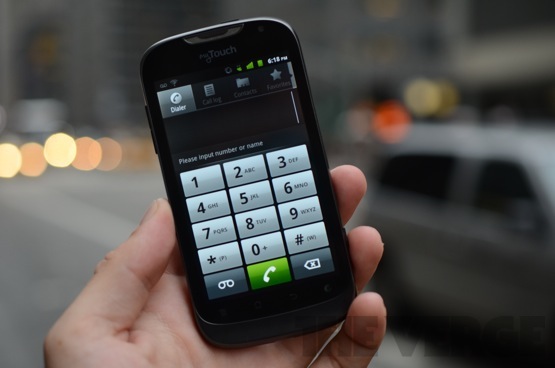
I owned a variety of flip phones over the years, and I miss two things most about them: their batteries lasted basically forever and their call quality was phenomenal. Before low-end smartphones can really catch on, they're going to need to achieve (or at least approximate) both of those features as well. Call quality, at least, can be checked off the list: I sounded crystal clear to callers while talking on the MyTouches, and could hear them quite well too. Even speakerphone is good — I was totally audible even with the MyTouch an arm's length away, which is rare.
Reception was solid, about what you'd expect from T-Mobile — its HSPA+ network is very fast, but not nearly as widespread as the other, larger carriers. I saw download speeds between 2Mbps and 6Mbps on both phones, and uploads averaged 1-2Mbps — that slowed down during peak hours in New York City, but that's the case with every phone on every carrier.
Battery life, unfortunately, isn't quite up to the don't-think-about-it feature phone standard. Getting a full day out of the MyTouch models is easy, and I could even leave it unplugged over night and have some juice left in the morning, but a day and a half is stretching the MyTouches' lifespan. That's good, but I remember years ago not even thinking about my phone's battery for days at a time – sadly, we're not quite there yet.
Not quite to "leave your charger at home" status
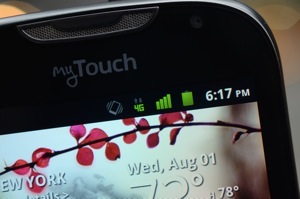
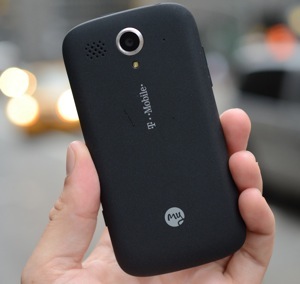
So close to replacing your feature phone, but yet so far
The MyTouch and MyTouch Q are not designed for anyone who's ever owned a smartphone before. They're for people who don't want to pay a ton for their phone, but want fast internet, email, and some games on their phone. There's a lot to like here, especially for the price: call quality is outstanding, performance is solid, and even the camera is better than expected for a $49 phone. The Q even has a solid keyboard, if you can't live without the physical keys. But it all comes down to the software, and Android 2.3 leaves the MyTouches severely hamstrung. Without the latest, fastest, most attractive version of Google's OS, you'd be buying a phone that's not nearly as good as it could be.In the very near future, some manufacturer will release a phone like the MyTouch — decent but unspectacular specs, decent but unspectacular performance — that runs Android 4.0 (or even 4.1), and gets all the improvements and new apps that come with the upgrade. Then, and only then, will a $49 smartphone feel like a good deal.
So close to replacing your feature phone, but yet so far
The MyTouch and MyTouch Q are not designed for anyone who's ever owned a smartphone before. They're for people who don't want to pay a ton for their phone, but want fast internet, email, and some games on their phone. There's a lot to like here, especially for the price: call quality is outstanding, performance is solid, and even the camera is better than expected for a $49 phone. The Q even has a solid keyboard, if you can't live without the physical keys. But it all comes down to the software, and Android 2.3 leaves the MyTouches severely hamstrung. Without the latest, fastest, most attractive version of Google's OS, you'd be buying a phone that's not nearly as good as it could be.In the very near future, some manufacturer will release a phone like the MyTouch — decent but unspectacular specs, decent but unspectacular performance — that runs Android 4.0 (or even 4.1), and gets all the improvements and new apps that come with the upgrade. Then, and only then, will a $49 smartphone feel like a good deal.
:format(webp)/cdn.vox-cdn.com/uploads/chorus_asset/file/12798245/DSC_7309-hero.1419971752.jpg)
:format(webp)/cdn.vox-cdn.com/uploads/chorus_asset/file/12798245/DSC_7309-hero.1419971752.jpg)
Share this story